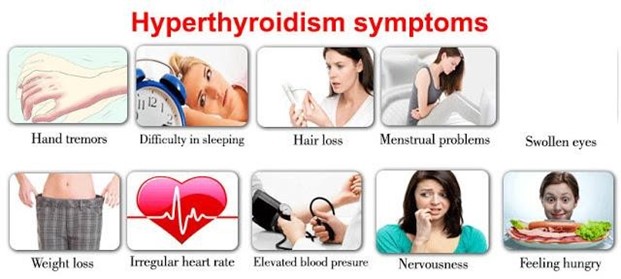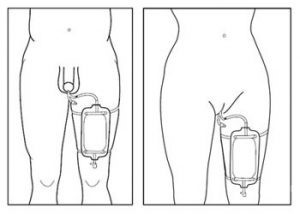A nurse is reinforcing teaching with a client who has hypothyroidism and a new prescription for levothyroxine.
The nurse should instruct the client to notify the provider of which of the following manifestations of thyrotoxicosis?
Nervousness
Pruritus
Cough
Polyuria
The Correct Answer is A
Explanation
A, Nervousness
Levothyroxine is a medication used to treat hypothyroidism, a condition in which the thyroid gland does not produce enough thyroid hormones. Thyrotoxicosis, on the other hand, is a condition characterized by an excess of thyroid hormones in the body, which can occur as a side effect of levothyroxine or other thyroid medications.
Nervousness is a common symptom of thyrotoxicosis. Excess thyroid hormones can lead to increased sympathetic nervous system activity, causing symptoms like nervousness, restlessness, anxiety, and palpitations.
Pruritus (itching) in (option B) is not correct because it is not a typical manifestation of thyrotoxicosis. Itching is not directly related to thyroid hormone levels and is more likely to be associated with other conditions or medication side effects.
Cough In (option C) is not correct because it is not a typical manifestation of thyrotoxicosis. Coughing is not a symptom directly related to thyroid hormone levels and is more likely to be associated with respiratory or other conditions.
Polyuria (increased urination) in (option D) is not correct because it is not a typical manifestation of thyrotoxicosis. Polyuria is not a symptom directly related to thyroid hormone levels and is more likely to be associated with other conditions, such as diabetes or kidney problems.
If the client experiences symptoms of thyrotoxicosis, such as nervousness, palpitations, or any other concerning signs, it is essential to notify the healthcare provider promptly. The provider may need to adjust the dosage of levothyroxine or consider other treatment options to address the excess thyroid hormone levels and ensure the client's well-been

Nursing Test Bank
Naxlex Comprehensive Predictor Exams
Related Questions
Correct Answer is D
Explanation
This response acknowledges the son's exhaustion and offers a constructive solution by suggesting respite care. Respite care provides temporary relief to caregivers by arranging for someone else to take over caregiving responsibilities for a specific period of time.
It allows caregivers to have a break and take care of their own physical and emotional well-being. By providing information about respite care, the nurse is offering support and resources to help alleviate the son's fatigue while ensuring that the mother's care needs are still met.
Correct Answer is ["C"]
Explanation
A: The tubing should not be coiled on the bed, especially not above the collection bag, as this can interfere with the drainage of urine and increase the risk of infection.
B: The drainage bag should always be kept below the level of the bladder during ambulation to prevent backflow and reduce the risk of infection.
C: Securing the catheter tubing to the lower abdomen (for male clients) or thigh (for female clients) helps to reduce the risk of catheter displacement and trauma. Proper securing also prevents unnecessary tension on the tubing, which can cause urethral irritation.
D:A sterile specimen should be collected from the sampling port of the catheter tubing, not directly from the drainage bag, which could lead to contamination.

Whether you are a student looking to ace your exams or a practicing nurse seeking to enhance your expertise , our nursing education contents will empower you with the confidence and competence to make a difference in the lives of patients and become a respected leader in the healthcare field.
Visit Naxlex, invest in your future and unlock endless possibilities with our unparalleled nursing education contents today
Report Wrong Answer on the Current Question
Do you disagree with the answer? If yes, what is your expected answer? Explain.
Kindly be descriptive with the issue you are facing.
